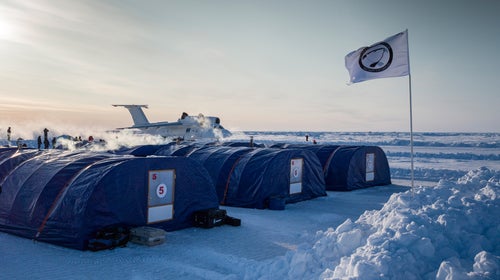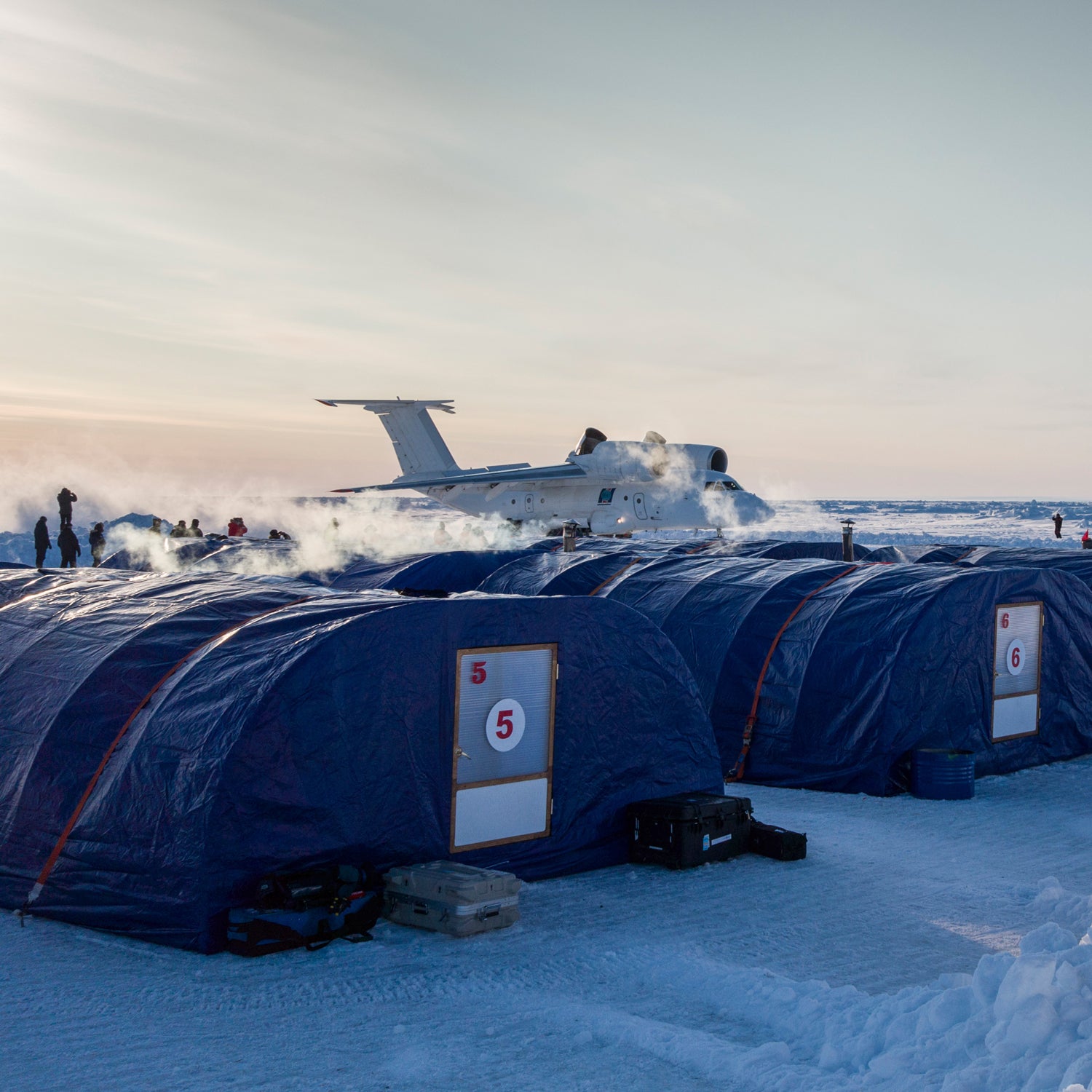Every March, Russia sends an elite team of engineers to the North Pole to pave a 4,000-foot-long landing strip and establish a corresponding base camp on a floe just off the polar ice cap roughly 60 miles from the top of the world.¬Ý
It’s a mind-blowing logistical feat that involves parachuting two hybrid tractor-bulldozers and 50 tons of equipment from an industrially fortified cargo plane onto sheets of moving ice. A 20-person crew works for five days nonstop, breaking up massive pressure ridges of ice using drills, shovels, and pickaxes to make way for the tractors to plow an airstrip. They then construct a tent city big enough to host the inevitable array of adventure tourists, polar athletes (last-degree skiers, ballooning enthusiasts, dog-sledders), and climate scientists from around the world who also use Barneo as a base for gathering data on the ever-shifting Arctic landscape.
The Barneo Ice Camp usually opens at the beginning of April and operates for only one month‚Äîthat short window when the polar night has ended but the winter pack is still thick, before temperatures rise and the ice pack becomes treacherous. Each year, about 250 visitors cycle through Barneo, where they can enjoy a lecture on oceanography, hot borscht in the heated mess hall, or a traditional Russian banya. The camp offers the most convenient and least expensive way to reach the pole by air, and Barneo is only accessible by flights from Longyearbyen, a coastal hamlet on the island of Svalbard,¬Ýitself¬Ýwell inside the Arctic Circle.
It’s typically a straightforward procedure—the runway was perfectly stable in 2014 and 2015. But this year was different. On April 4, the ice floe supporting Barneo suddenly cracked, delaying dozens of athletes, including 55 runners from 23 different countries who had come to compete in the annual North Pole Marathon, and sparking a geopolitical quarrel between two of the countries vying for their piece of the pole: Russia and Norway.
“Who has the right to determine whether the Russian military, Canadian military, or American military can train in the Arctic? What document says they aren’t allowed to do this?”
The North Pole and the massive ice sheets surrounding it aren‚Äôt owned by any country, but that hasn‚Äôt stopped the five Arctic coastal nations‚ÄîRussia and Norway, along with the U.S., Canada, and Denmark‚Äîfrom staking various unofficial claims to the territory and its resources. Each is vying for control over shipping routes (some of which have yet to materialize) and exclusive rights to portions of the region‚Äôs oil-rich seabed. Russia in particular has made no secret of its ambitions there, which include¬Ý¬Ýas well as¬Ýoil prospecting and carving new shipping lanes. Over the past five years, the country has its Arctic conducting drills which Foreign Minister Sergey Lavrov defended earlier this year as essential training for survival and rescue operations, but which have .
The day before the crack, on April 3, Russia airdropped a group of 15 Chechen soldiers onto Barneo to conduct military drills without having notified Norway first. When the runway cracked the following day, the paratroopers helped rebuild it, a fact Chechnya’s president, Ramzan Kadyrov, with a jubilant video of soldiers in high-tech polar gear brandishing machine guns, and the Chechen flag unfurling over the Arctic Ocean. Kadyrov stated that, in addition to completing a “full battery of tactical exercises,” the team put “special effort into constructing the runway,” and referred to the soldiers as “our heroes.”
For nine days, the runway was in a constant state of repair. Irina Orlova, a Russian who is one of Barneo’s main logistics coordinators, says that while turbulent cross winds and ocean currents were contributing factors, global warming likely accounts for the difficulty the crew faced in both finding and maintaining an adequate floe this year. It takes a chunk of ice about the size of six city blocks to provide adequate room for a landing strip, and even with the help of satellite technology, Russian pilots can only guess at a floe’s thickness from above the Arctic sea.
On April 12, the runway was re-established on a new floe, and the first group of skiers who‚Äôd been waiting in Norway‚Äîincluding Masha Gordon, who recently broke the women‚Äôs speed record for climbing all Seven Summits and skiing both poles, a feat known as the Explorer‚Äôs Grand Slam‚Äîwas finally able to fly out to Barneo. Scarcely had the team made its final hop to the polar ice cap by helicopter, when the Norwegian government suddenly announced it was revoking permits for 11 remaining flights out of Longyearbyen. The Russians logistics team was told to reapply for flight permits.¬Ý
The official reason given was bureaucratic: Norway recently toughened its flight permitting requirements, period. But a post on the official lays the blame on an exposé published about the Chechen military exercises in an online Norwegian news site: “The Independent Barents Observer reporter found a threat to national security in our conventional activities. On these grounds the Norwegian authorities made the transportation rules much more rigorous.”
Polar explorer Eric Larsen was guiding Gordon and other skiers to the pole at the time. He and his clients were among the people stranded at Longyearbyen during the exchange. ‚ÄúNorwegians requiring 48 hours between flights. It‚Äôs the Cuban Missile Crisis up here!‚Äù Larsen wrote in an email to ∫⁄¡œ≥‘πœÕ¯.
The standoff could be the first of many political disputes to disrupt the region as interest there grows, and the agreements over how the Arctic may be used and by whom are becoming outdated. For example, the Chechen exercise is a potential violation of , which states that ‚Äúall foreign military activity in Svalbard is prohibited and would entail a gross infringement of [Norwegian] sovereignty.‚Äù¬Ý
Furthermore, Orlova says that a journalist in the area allegedly saw president Kadyrov on board one of the supply planes flying from Longyearbyen to Moscow. Kadyrov, a former Chechen rebel leader, has been accused of murdering and torturing his enemies, and is a vocal supporter of practices such as honor killing and polygamy. The rumor that he was present was further , where allegations arose that the soldiers, along with Kadyrov, had , before flying on to Barneo. “How do you like that?” Orlova says.
Orlova states that Barneo is “strictly non-political” and the camp’s staff had nothing to do with the Chechen maneuvers, but adds, “Who has the right to determine whether the Russian military, Canadian military, or American military can train in the Arctic? What document says they aren’t allowed to do this?”
The flight blockade was finally lifted on April 13 after multiple appeals from the polar explorers grounded in Longyearbyen, which included a “” sent to Norway's civil aviation authority by North Pole Marathon Director Richard Donovan.
The Russians are hoping this year’s warm winter weather was an anomaly and their runway doctors won’t face the same problems with the ice next season. “Building the base and saving runway [sic] is getting more and more difficult,” says Victor Boyarsky, head of the Russian Geographical Society’s polar commission and one of Barneo’s founders. “But we do hope that we always will be able to launch the base at least for couple of weeks every year.”
As for the future of Norway’s relationship with Russia, that’s less certain. At the end of this year’s season, Barneo staff announced they would be moving their logistics base to Russia next year, specifically the remote territory of Franz Josef Land. Getting there will require a visa, and there’s far less infrastructure for tourism.
Larsen, who already has clients interested in returning to Barneo next year, is nonchalant about the added hassle. Getting to the top of the world has never been easy, he points out, and the latest political squabbling is just one more shifting piece of the Arctic puzzle. “It's just the nature of the beast,” he says.


